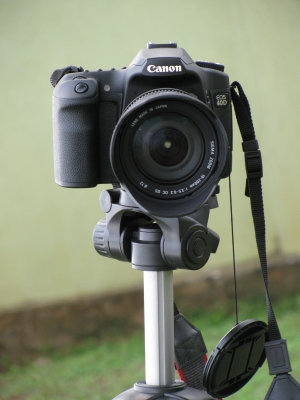A camera tripod is like a spouse: something steady to rely on
Your trusty camera tripod will come in very handy on dark, grey days. But there are other advantages to shooting with a tripod: the ability to capture motion without causing unwanted blur and the ability to precisely frame your object (in studio photography, for example).
How to choose a camera tripod that fits your needs and budget, and how to make an improvised tripod out of a bag of rice.

Why do you even need a camera tripod?
Tripods are mainly used for the following:
- Shooting something that’s moving without causing any unintentional blur Ttaking a long exposure photo of a waterfall, for example. Shooting this without a tripod might cause blurring above and beyond the blurring in the water that we intended to capture. Read more about shooting movement.
- Doing a self-portrait or a group photo In combination with the camera’s built-in timer, a tripod positions and stabilizes the camera, which lets you take a self-portrait or a group photo without the assistance of a passerby who will most likely press the wrong button, mess with your camera settings, and only capture your torso and legs.
- Long exposure photography in low lighting Taking a photo of the stars at night, or the shadows created by the moonlight hitting your house. These kinds of shots require long exposure from a few seconds to tens of seconds, and can only be done using a camera tripod set on a steady surface.
- Focused photography When we shoot a flower from a certain angle, or a model in the studio, the tripod lets us set and define the framing of our object and makes the camera less sensitive to the movement and shaking of our hands.

Which Camera Tripod Should You Choose – Three Legs? Five Legs? Maybe Just One?
 Camera tripods come in various kinds, each with its pros and cons and you should choose based on your needs:
Camera tripods come in various kinds, each with its pros and cons and you should choose based on your needs:
- A monopod: A monopod looks like a tall walking cane and it lets you quickly stabilize your camera while running around. It is used, for example, by professional sports and news photographers who need to be very mobile but still want to take sharp photos.
- A tripod: Tripods are the most common of the group and they are used in various conditions. They present a good balance between weight and steadiness.
- A pentapod: A pentapod is mainly used with large zoom and telescopic lenses. These heavy lenses tip the camera forward, which poses a need for something substantial to keep the camera from shaking.
- Minipods: These are the tripod’s distant relatives and they assist the photographer in placing the camera on uneven surfaces and other tricky spots. They are also small enough to fit a small camera bag. Many people buy them to use with their point-and-shoot cameras, but they are usually far too small for professional cameras.
Which material makes a better camera tripod – aluminum or carbon fiber?
Camera tripods made of aluminum are the most common mainly because they are more affordable, and when you’re starting out most of your accessories budget goes to quality lenses and a good camera bag.
Carbon fiber tripods are much lighter and, therefore, preferred by the more serious photographer. They may also be cheaper in the long run, as they can save you on chiropractor bills…
It’s important to note that despite their light weight, carbon fiber camera tripods are not less stable than their aluminum counterparts.
Other factors to keep in mind when buying a camera tripod:
- Hooking up the camera Consider the way your camera will connect to the tripod. There are two kinds of hook ups – screw on, and snap on. The screw on kind is stronger and will anchor almost any digital camera to the tripod with a standard screw that fits a threaded hole in the camera. The snap on variety, on the other hand, makes the connection via a small apparatus that connects to the tripod. The advantage here is that it makes it easy to quickly pull the camera off, take some pictures and then reconnect the camera. The downside of the snap on devices is that they are not as steady as the screw on devices (which are slower to connect and disconnect).
- Weight constraints Camera tripods have specifications regarding the maximum weight they can hold. As a rule of thumb, make sure the specified maximum is more than double the weight of your camera combined with the weight of your heaviest lens. This will guarantee that your tripod will remain steady for a very long time.
Making an improvised field tripod
Use these ideas when you want to take a quick photo and your tripod is out of reach:
- Your car’s roof, a shelf, or a stable surface The key here is to find a good surface and place the camera in a way that will make sure that the surface you’re using doesn’t appear in the actual photo. Also, be aware of lighting and reflections from the surface you’re using – especially when you’re using the flash.
- A Bag of rice A bag of rice that is not filled to the brim can be a great makeshift camera tripod. Place the camera on the bag and you’re good to go (it might require some trial and error).
By the way, if you are using a long lens you will need to place something underneath it (a pebble, some fabric) to prevent the lens from pulling your camera downward and ruin your shot.